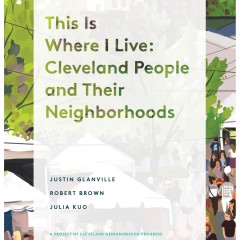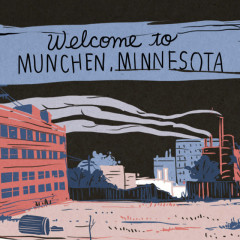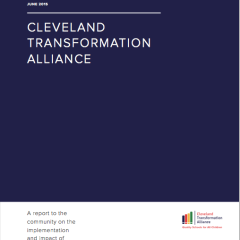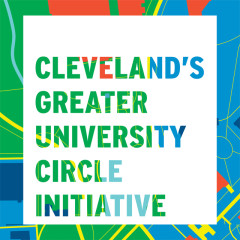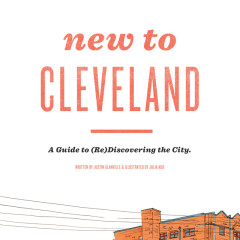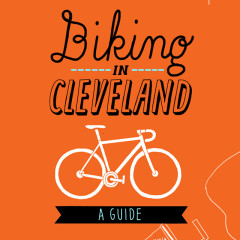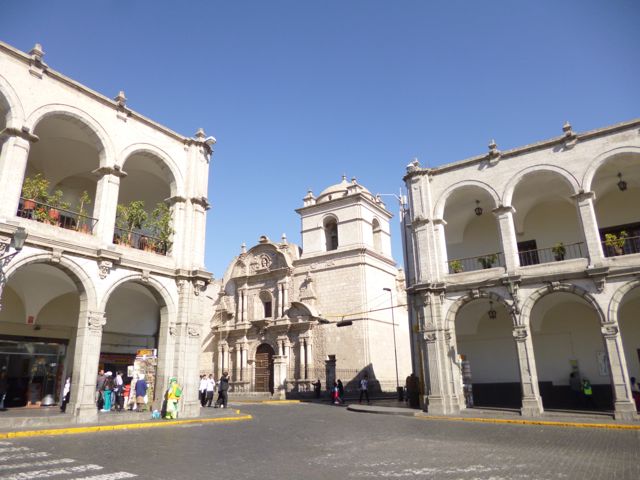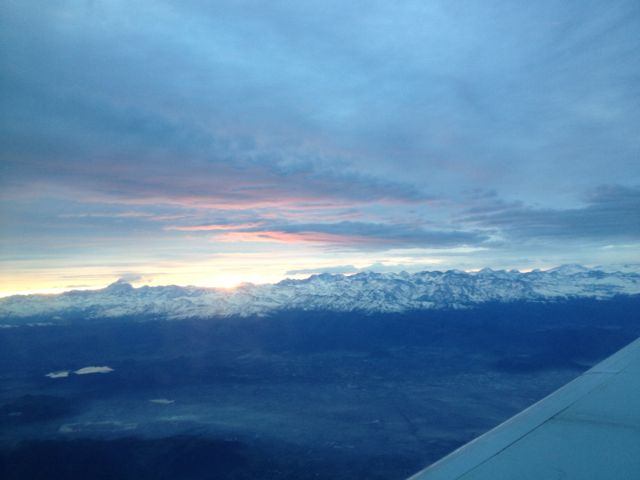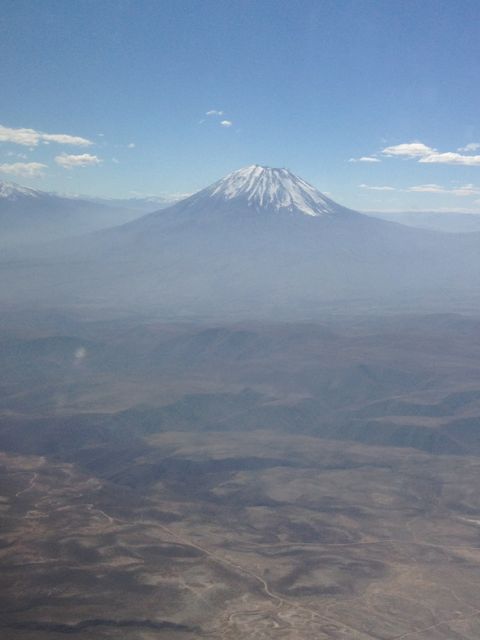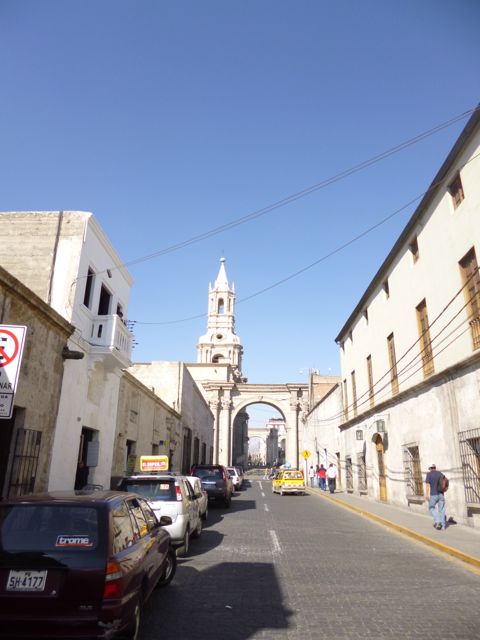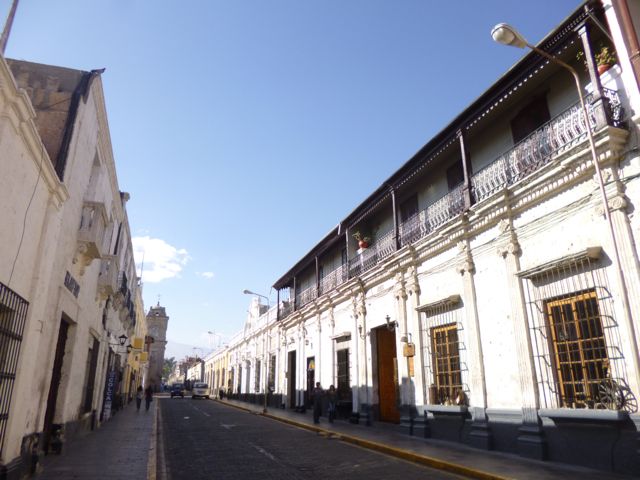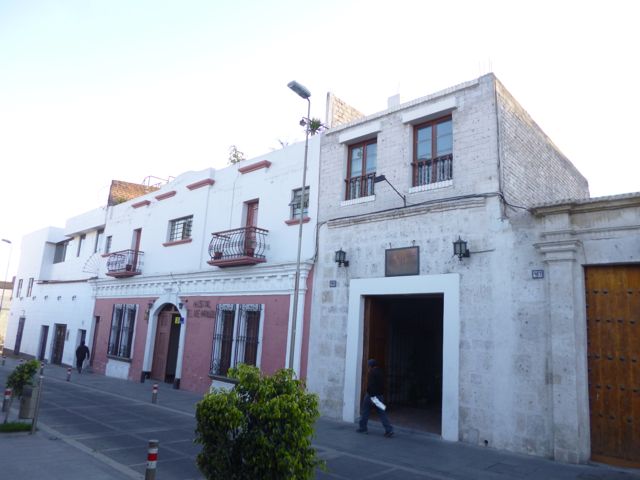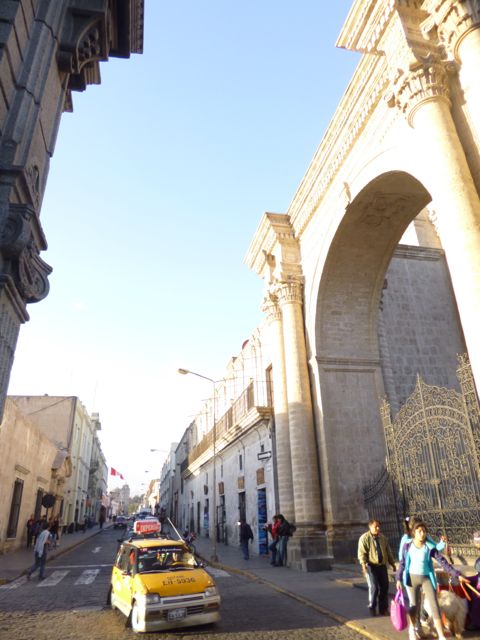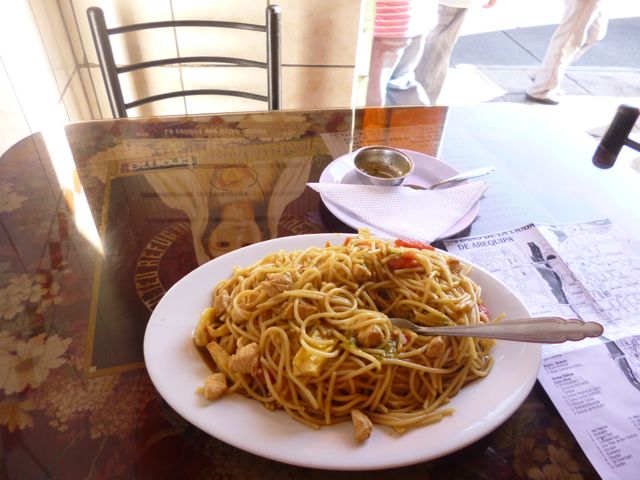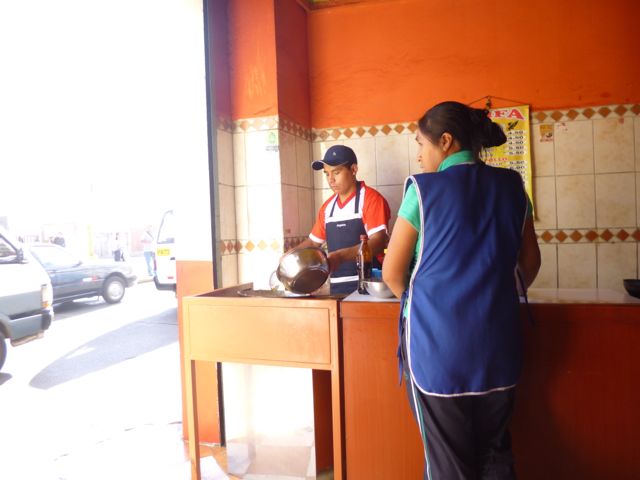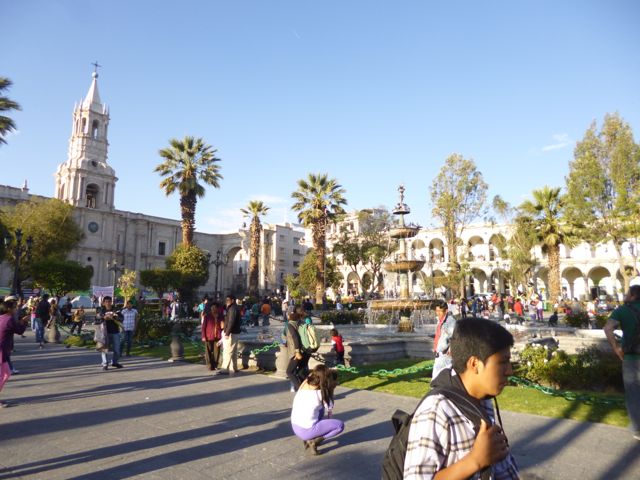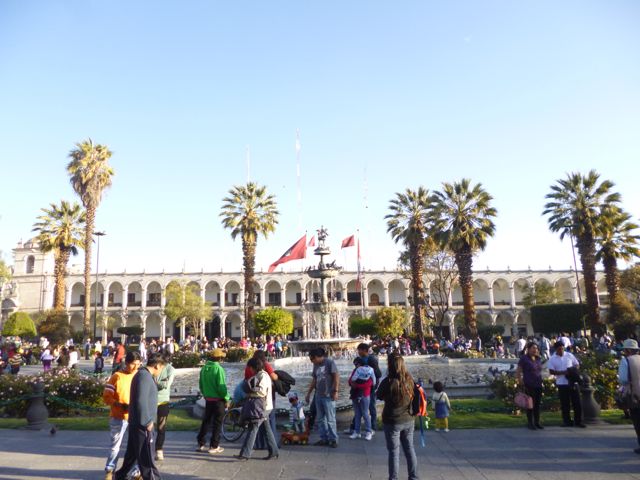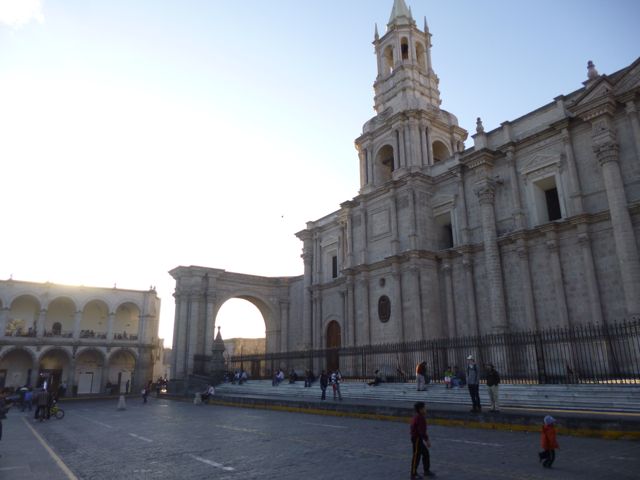Another travel-dominated day, one that would take me 1,600 miles from Santiago to Arequipa, Peru, where I’d begin the next chapter of my trip.
My flight, operated by the Chilean airline Sky, hopscotched its way north, landing first in Antofagosta and then Arica, both cities in northern Chile surrounded by brown desert and mountains, before crossing the border into Peru. Here’s the sun rising over the Andes as we left Santiago:
At Arica, we had to leave the plane and go through Chilean customs. In line, I met two American college women, Hillary and Mary, who’d spent the last semester studying in Santiago. They were planning to do some hiking in Colca Canyon, a couple hours outside Arequipa, before returning home. (Tip: If you’re planning on taking this flight, it’s better to buy your ticket in Chile than online. You can only buy round-trip tickets online.)
They told me more about the student protests in Chile from their perspective. Apparently, high school students — not college students — initiated the movement, enraged about the poor quality of free public high schools compared with paid private ones. The college students, meanwhile, are protesting mostly on behalf of the high school students, and only secondarily about the quality and cost of college education. Also, college students vote every week whether they want to have classes, or strike. It’s entirely up to them, with the administrators having little or no say.
We talked about how the situation’s essentially the same in the U.S. — the education system is set up to perpetuate preexisting social inequities — and yet the sense of anger and/or empowerment that U.S. students feel is entirely different. Maybe the division isn’t quite as stark between public and private; there are many excellent public schools in the U.S., though of course most of those are in rich suburbs. Still, the idea of U.S. college students, let alone high school students, staging nationwide protests about the quality and cost of education — successfully disrupting the system in the process — is unimaginable. What’s the difference? Are things not as bad in the U.S.? Or do we simply believe more in the idea of self-invention?
I already had a premonition I’d really like Arequipa, and the views on our descent into the city only confirmed my optimism. Here is El Misti, the volcano on the city’s outskirts:
I got to Arequipa around noon, and taxied into town with the two college kids (10 Peruvian Soles apiece, or about $3.50). Within minutes, the place had thoroughly, thoroughly enchanted me. I’m not sure if I’ve ever been anywhere so immediately delightful. The weather is sunny without being hot or humid — a function of its extreme elevation, 7,661 feet, or half a mile higher than Denver. In the background, as in Santiago, loom the Andes, including a snow-covered volcano called El Misti.
The old center has beautifully preserved colonial buildings made of sillar, a white volcanic stone that subtly sparkles in the sun. It’s immaculately clean, and yet bustling and crowded enough not to feel antiseptic.
And there are other Americans here! For the first time, I’m hearing American English spoken on the streets. While that usually annoys me, I’m kind of grateful for it now.
I checked into my hotel, La Hosteria, which seems luxurious after Cobweb Cabin — an old colonial house with tile floors and creaky wooden doors. It’s costing me about $65 a night, which I’ve since learned is very expensive by Peruvian terms, but again I already made a reservation and didn’t want to risk violating the cancellation terms. Here’s the place, on the right:
I wandered around the city, feeling happy just to be here. There’s something about this place that feels so much more approachable than Santiago or Valpo. People are friendlier. There are no buildings en toma (though I liked seeing that too) and people smile more. The sidewalks and streets are clean. The sun shines constantly but not naggingly, because there’s no humidity and the temperature rises no higher than 70 — typical weather here, I’ve learned. It’s sometimes called the city of eternal spring.
And the sillar! This is the white volcanic stone out of which most of the buildings in the old center are made (and out of which the whole city was constructed from its founding in about 1570 until about 1850). A pearly white, rough-textured, with just enough dark patches to let you know you’re looking at something flawed, something that came from the earth.
I found myself on a busy street called Salaverry, where the tourist count dwindled to almost zero. Microbuses roared past, jockeys leaning out the side doors to call for passengers, just as in Guatemala. I started to see a million little hole-in-the-wall restaurants with their menus out front, offering things I’d never heard of: tallerin, chufa, and — most intriguingly — something called aeropuerto. A cook at one of these places worked right in the front of the restaurant, frying noodles with vegetables and mysterious sauces. It looked delicious, and I ordered some for myself. It was tallerin, which turned out to be a spaghetti noodle base. I watched, mesmerized, as the cook added mysterious sauces, tomatoes, french fries (yay!) and chicken. (There were no vegetarian options, and the idea of protein appealed to me after weeks of carbs.) When it was done, a waitress brought me a little dish of green sauce, which I happily dumped on top.
The stuff was delicious. It tasted like a cross between Cincinnati chili, a Chinese stir fry and an Indian curry. I wolfed it down, gazing out at the busy sidewalk where fumes from the cook’s station mixed with exhaust from the microbuses, creating an intoxicating fog of urbanity. It felt good, a welcome contrast to my beautifully lonely days on Easter Island. And the price for that big plate of food? S/5, or about $1.75.
Gorged, I tottered back to the main square, the Plaza de Armas. There’s a grocery store right on the square, El Super, and I bought some vegetables and fruit. (More inexpensiveness! About $5 for a big bag of groceries.) I ran into the college girls again, along with two Peruvian guys they’d apparently met at the store. Both the guys were drinking cans of beer right in the store. I guess you can do that here.
The girls invited me to go to Colca Canyon with them the next day. I thanked them for the invite and said I’d think about it and email them, but I knew right then I wouldn’t go. Arequipa was turning out to be the perfect way station between my adventures on the island and the ones that were to come in Cusco and Machu Picchu. This place felt restorative, calming, to me, like the perfect place to recharge after my exertions (physical and I guess emotional too) on Easter Island and my upcoming ones at Machu Picchu. Why not simply allow myself to stay, enjoy the city, to soak it all in?
I hauled my grocery bags outside, intending to sit and people watch for a while. The Plaza de Armas here may be the most cheerful and beautiful central square I’ve ever visited. It was tough to find a seat on a bench, so full was it of a healthy mix of Peruanas and taller, whiter tourists, so for a while I sat on a curb on the ground.
The two Peruvian guys from the store — apparently having been ditched by the girls — walked up.
“You look like you’re meditating,” one said in English.
“Ha! That’s funny. Yeah, maybe I am.”
“Want a beer?” His friend held out a can to me.
“Oh — no, that’s all right. Thanks, though.”
“I live in California now,” the first guy explained. “I’m here visiting. This is where I’m from.”
“It’s such a beautiful city,” I said. “I’ve only been here a few hours and I love it already.”
“Yes, it’s good to be back. It’s different here than in the states. People are more… together here. It’s all one community.”
He was right. Arequipa felt like one big, city-sized family. Already, I’d met more people here than I had my whole time in Chile. We chatted a little longer, and they moved on, probably trying to find more female tourists. I found a tight spot on a bench between an old lady and a young kid listening to his headphones. Eventually, the first old lady left and another one took her place, accompanied by a little girl who must have been her granddaughter.
A constant stream of vendors circled the plaza, selling sweets and trinkets, and the grandma bought a packet of birdseed. She showed the little girl how to scatter it for the pigeons. The little girl didn’t quite get it, dropping the seed at her feet so the pigeons were too afraid to eat. Eventually, another little girl tottered over, a stranger, and the grandmother handed her some birdseed, too.
This was exactly what public squares are supposed to be, wasn’t it? Big, outdoor living rooms. A gathering place for a hyper-extended family. We’ve lost that in the U.S., choosing to isolate ourselves instead. Thanks to some mix of race and class tension, our dependence on driving, and our love affair with technology. It’s too bad, because being in this environment unearthed a deep sense of calm in me. Sort of like I felt standing before the moai that first night on Easter Island. The sense of connectedness.
When I got home, it finally occurred to me that I’d been utterly reckless in my consumption choices since arriving in Peru, so enchanted was I with Arequipa. People get sick here all the time from eating street food and drinking the tap water. I hadn’t drunk any tap water yet, but I had had a big steaming plate of street food. And I hadn’t washed my hands once.
Shoot. I didn’t really care about getting sick per se, but I wanted to be in decent shape to hike the Inca Trail. I pictured myself hobbling along the stone stairways, having to run off into the bushes every few seconds to take care of business.
Perhaps psychosomatically, my belly began to gurgle. As a preventative measure, I walked to a pharmacy and bought some bottled water, Pepto Bismol and Cipro, which you can buy over the counter here. I drank some of the chalky pink stuff and went to bed with a little prayer to the travel gods to keep my bowels in good working order.



